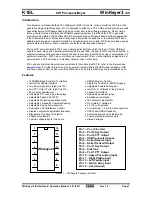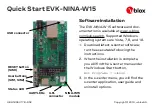
!
WARNING
Introduction
This Installation Guide provides instructions for
installation, startup and adjustment. To receive a
copy of the Instruction Manual, contact your local
Sales Office or view a copy at www.fisher.com. For
further information refer to Y692VB Series Instruction
Manual, D102661X012.
PED Category
This product may be used as a safety accessory
with pressure equipment in the following Pressure
Equipment Directive. It may also be used outside
of the Pressure Equipment Directive using Sound
Engineering Practice (SEP) per table below.
For information on the current PED revision see
Bulletin:
Specifications
Body Sizes and End Connection Styles
(1)
DN 40 / NPS 1-1/2 :
NPT, SWE, CL150 RF,
CL300 RF and PN 16/25/40
DN 50 / NPS 2:
NPT, SWE, CL125 FF, CL150 RF,
CL300 RF and PN 16/25/40
Maximum Allowable Inlet (Positive) Pressure
(2)
and
Orifice Sizes
19 mm / 3/4-in. Orifice:
2.1 bar / 30 psig
30 mm / 1-3/16-in. Orifice:
0.90 bar / 13 psig
Vacuum Control Pressure Ranges
(2)
See Table 1
Maximum Casing Pressure
(2)
0.55 bar / 8 psig Vacuum
Pressure Registration
Type Y692VB:
Internal
Type Y692VBM:
External
Spring Case Connection
3/4 NPT
Type Y692VB Gauge Tap Connection
1/4 NPT
Type Y692VBM Control Line Connection
1/2 NPT
Temperature Capabilities
(2)
Nitrile (NBR):
-40 to 82°C / -40 to 180°F
Fluorocarbon (FKM):
4 to 149°C / 40 to 300°F
Ethylenepropylene (EPR):
-29 to 93°C /
-20 to 200°F
Perfluoroelastomer (FFKM):
-18 to 149°C /
0 to 300°F
Silicone:
-40 to 204°C / -40 to 400°F
Approximate Weight
Cast Iron:
20 kg / 45 lbs
Steel, Stainless Steel or Hastelloy
®
C:
26 kg /
57 lbs
Installation
Only qualified personnel shall install
or service a vacuum breaker. Vacuum
breaker should be installed, operated
and maintained in accordance with
international and applicable codes
and regulations and Emerson Process
Management Regulator Technologies,
Inc. instructions.
If using a vacuum breaker on a
hazardous or flammable fluid service,
personal injury and property damage
could occur due to fire or explosion of
vented fluid that may have accumulated.
To prevent such injury or damage,
provide piping or tubing to vent the
fluid to a safe, well ventilated area or
containment vessel. Also, when venting
a hazardous fluid, the piping or tubing
should be located far enough away
from any buildings or windows so to
not create a further hazard and the vent
opening should be protected against
anything that could clog it.
Installation Guide
D102661X014
January 2010
Y692VB Series
PRODUCT SIZE
CATEGORY
FLUID TYPE
DN 40 to 50 /
NPS 1-1/2 to 2
I
1
Hastelloy
®
C is a mark owned by Haynes International, Inc.
1. End connections for other than U.S. standards can usually be provided; consult your local Sales Office.
2. The pressure/temperature limits in this Installation Guide and any applicable standard or code limitation should not be exceeded.






















